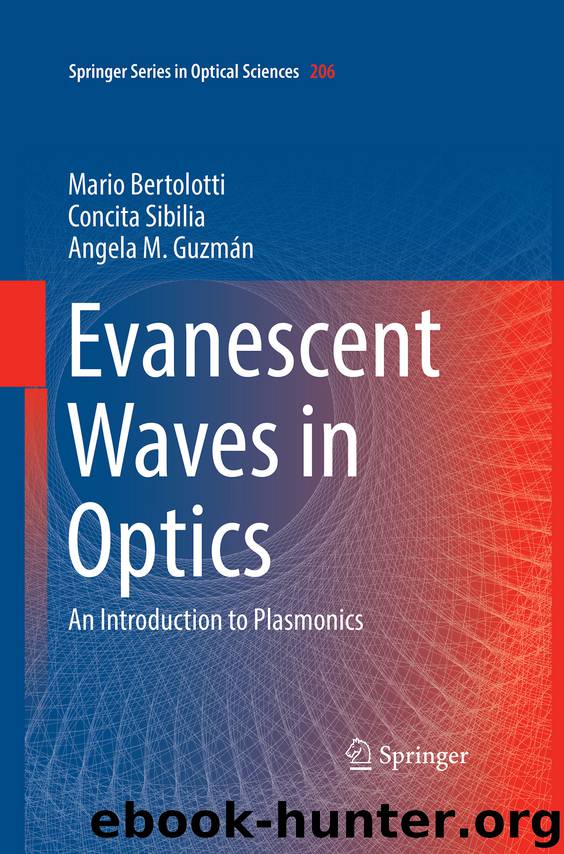Evanescent Waves in Optics by Mario Bertolotti Concita Sibilia & Angela M. Guzmán

Author:Mario Bertolotti, Concita Sibilia & Angela M. Guzmán
Language: eng
Format: epub
Publisher: Springer International Publishing, Cham
The maximum possible field enhancement on a smooth surface is
(5.44)
where
Elight is the electric field of the incident light, εi, εm and εs are the dielectric constant of the adjacent medium, metal, and of the prism through which the metal film is illuminated to excite SPP, respectively. For a 60 nm thick silver film illuminated with red light, the intensity enhancement can reach more than two orders.
The parallel components of the wavevector necessary for plasmon excitation can also be found if the metal surface is rough11 or are present suitably designed metallic particles. The scattered field wave-vector can match with the field component of SPP waves so that coupling to SPP can be accomplished locally.12 On a rough surface, the SPP excitation conditions can be achieved without any special arrangement. Diffraction of light on surface features can provide coupling to the SPP modes because the diffracted components of light with all wave-vectors are present. However, the conditions for excitation are hill defined and the light coupling is not efficient.
Figure 5.12 shows excitation with a SNOM probe or by diffraction on surface features.
Fig. 5.12Excitation of plasmons with a SNOM probe (upper) or by diffraction on a small particle (lower)
Download
This site does not store any files on its server. We only index and link to content provided by other sites. Please contact the content providers to delete copyright contents if any and email us, we'll remove relevant links or contents immediately.
| Automotive | Engineering |
| Transportation |
Whiskies Galore by Ian Buxton(41529)
Introduction to Aircraft Design (Cambridge Aerospace Series) by John P. Fielding(32888)
Small Unmanned Fixed-wing Aircraft Design by Andrew J. Keane Andras Sobester James P. Scanlan & András Sóbester & James P. Scanlan(32573)
Craft Beer for the Homebrewer by Michael Agnew(17933)
Turbulence by E. J. Noyes(7700)
The Complete Stick Figure Physics Tutorials by Allen Sarah(7137)
Kaplan MCAT General Chemistry Review by Kaplan(6595)
The Thirst by Nesbo Jo(6435)
Bad Blood by John Carreyrou(6274)
Modelling of Convective Heat and Mass Transfer in Rotating Flows by Igor V. Shevchuk(6222)
Learning SQL by Alan Beaulieu(6035)
Weapons of Math Destruction by Cathy O'Neil(5829)
Man-made Catastrophes and Risk Information Concealment by Dmitry Chernov & Didier Sornette(5646)
Digital Minimalism by Cal Newport;(5389)
Life 3.0: Being Human in the Age of Artificial Intelligence by Tegmark Max(5184)
iGen by Jean M. Twenge(5161)
Secrets of Antigravity Propulsion: Tesla, UFOs, and Classified Aerospace Technology by Ph.D. Paul A. Laviolette(4990)
Design of Trajectory Optimization Approach for Space Maneuver Vehicle Skip Entry Problems by Runqi Chai & Al Savvaris & Antonios Tsourdos & Senchun Chai(4839)
Electronic Devices & Circuits by Jacob Millman & Christos C. Halkias(4747)
